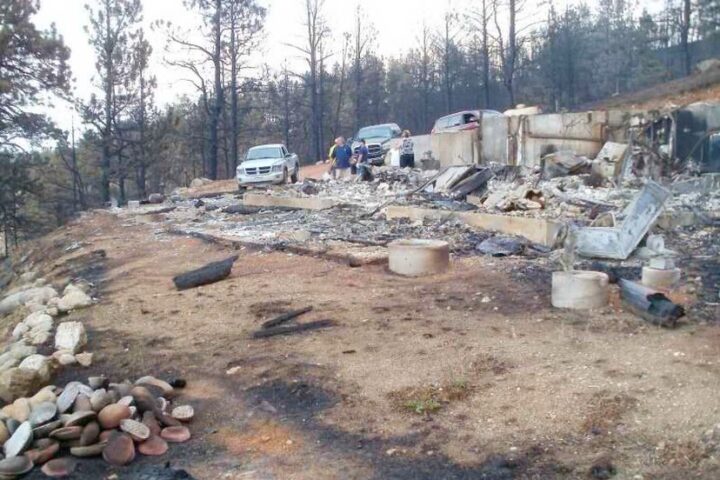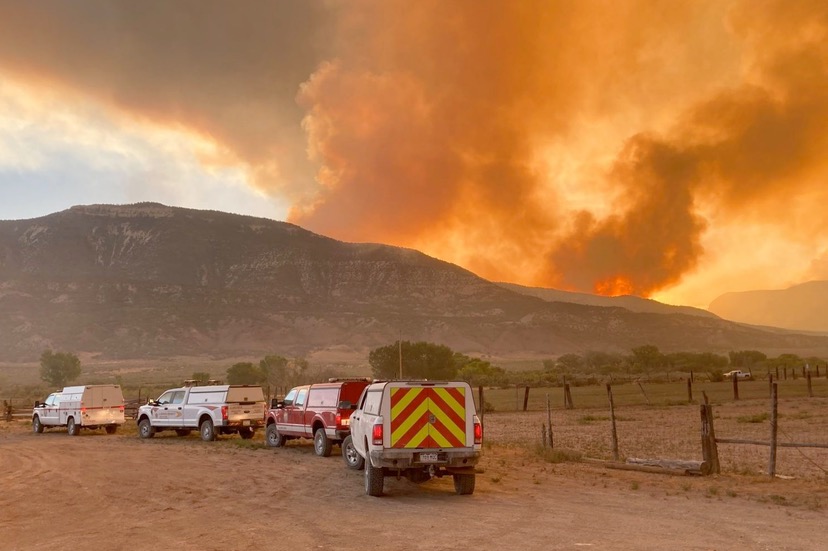The San Juan Headwaters Forest Health Partnership is a collaborative group committed to a better, healthier future. Partnership members are people and groups representing regional business interests, conservation organizations, local and state governments, federal agencies, recreation interests, ranchers, homeowner associations, scientists, and any interested citizens…
— from the San Juan Headwaters Forest Health Partnership website.
Last Friday, I attended a regular meeting of the San Juan Headwaters Forest Health Partnership (SJHFHP), a local volunteer group coordinated by Alex Handloff, Collaborative Communications Manager at Durango-based Mountain Studies Institute. The group’s work requires a close working relationship with the Pagosa Ranger District and the San Juan National Forest, since most of Archuleta County’s forest lands are federally managed.
As I understand it, the group’s primary interests are:
Forests that can resist catastrophic wildfires
Forests that nurture wildlife
Forests that provide wood products
Forests that may be resilient in the face of climate change
Forests that deliver pure water to various communities along the San Juan River
The group is supported by funding from about 42 organizations and government agencies. I’ve been attending the SJHFHP meetings (occasionally) as an unofficial representative of Pagosa Area Water and Sanitation District. PAWSD has been providing a bit of funding to SJHFHP for the past several years, and has an interest in some of the same issues, particularly forests that can resist wildfire, and a landscape that provides clean drinking water.
Disclosure: I currently serve as a volunteer member of the PAWSD Board of Directors, but this editorial reflects only my own opinions and not necessarily the opinions of the PAWSD Board as a whole, or of PAWSD staff.
The group discussed a half dozen forest-related topics at Friday’s meeting — all interesting topics — but the one I found myself thinking about, when I got home after the meeting was: Homeowners Insurance.
The subject was broached by local engineer Matt Ford, one of the key SJHFHP members. Besides his involvement with Forest Health Timber Products — a local lumber company — Mr. Ford is also involved in the real estate industry.
“I find myself asking about homeowners insurance on a regular basis, and so I spent some time going down the insurance rabbit hole, related to wildfire. I think it’s important to know, there’s a lot of stuff going on right now. Just some statistics. Colorado has the fourth largest five-year direct loss in the nation. And that has a lot to do with the high density fires on the Front Range. But another thing that I thought was interesting — and I’ll get to it in a second, because it will affect us all.
“Between 2019 and 2022, the average homeowners premium is up 51%…”
Mr. Ford was quoting from a document created for Colorado Division of Insurance.
Carriers have been shrinking their exposures in Colorado since 2021. Specifically, 76% of carrier groups shrank their exposure in 2022, with 32% of carriers shrinking by more than 10%, year-over-year.
“In other words, the market is currently consolidating under only the five largest carriers. Which will make things more monopolistic. My words, not theirs.”
This would suggest some homeowners will face insurance availability issues as soon as 2023.
“We’re already seeing that in Archuleta County…”
There’s significant correlation across many regions of the state, regardless of wildfire exposure.
“So when they look at insurance exposure and costs for consumers, it’s going to affect the person out on the flat Eastern Plains as much — or close to as much — as it will somebody in the mountains. That also goes for a fully isolated PLPOA resident versus someone who’s in the forest. There’s exposure for all of us.
“Another interesting thing. The ‘FAIR Insurance Plan’ was passed into legislation last year. It’s supposed to be an insurance program of ‘last resort’. But there are pretty strict guidelines…”
The Fair Access to Insurance Requirements (FAIR) Plan is a program designed to provide property insurance coverage for homeowners and businesses when coverage is unavailable through traditional means. HB23-1288 was passed by the legislature and then signed into law by Governor Jared Polis in May 2023.
The FAIR Plan was created to address situations where insurance companies may refuse coverage due to high-risk factors, such as the property’s location or vulnerability to certain perils such as wildfires. It ensures homeowners and businesses in Colorado have access to insurance even in areas prone to natural disasters or other risks. The Plan will provide up to $750,000 in property insurance coverage, and up to $5 million in commercial property insurance to eligible individuals and businesses in Colorado.
You can learn more about the FAIR program here.
If you are having trouble sleeping and you want to dig deeper into the insurance crisis in Colorado, here’s an April 2023 report from the Colorado Division of Insurance. (53 pages)

I will share more about this particular SJHFHP conversation in Part Two, but first, some personal information. Following the meeting, I looked up the change in my own fire insurance policy — really, a homeowners policy — since 2010.
I’ve had my homeowners insurance with the same company for 24 years. But I am paying a lot higher premium than I used to pay. During those 24 years, my house has not gotten any larger, nor has a new forest of flammable trees sprouted up in my neighborhood. But due to the hotter and hotter real estate market here in Pagosa Springs over the past decade, the assessed value of my house has increase substantially. The cost to replace my house, if it burned, may have increased even more.
In 2010, my homeowners policy cost me $630 a year.
By 2020, the price had increased to $1,476 a year.
Last year, my policy cost me $2,702.
That’s a considerably steeper increase than the 51% mentioned by the Colorado Division of Insurance.
How much higher can it go?

